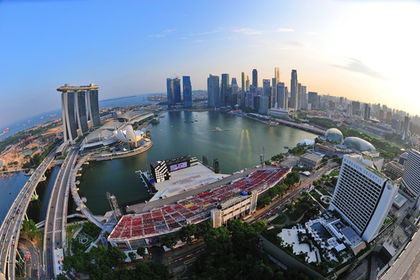SINGAPORE

Republic of Singapore
CAPITAL : Singapore
FLAG : The flag consists of a red stripe at the top and a white stripe on the bottom. On the red stripe, at the hoist, are a white crescent opening to the fly and five white stars.
ANTHEM : Long Live Singapore.
MONETARY UNIT : The Singapore dollar ( S $) of 100 cents is a freely convertible currency. There are coins of 1, 5, 10, 20, and 50 cents and 1 dollar and notes of 2, 5, 10, 20, 50, 100, 500, 1,000, and 10,000 dollars. S $1 = US $0.5617 (or US $1 = S $1.78) as of May 2003.
WEIGHTS AND MEASURES : The metric system is in force, but some local measures are used.
HOLIDAYS : Major Western, Chinese, Malay, and Muslim holidays are celebrated, some of which fall on annually variable dates because of the calendars used. Major holidays include New Year's Day, 1 January; Chinese New Year; Good Friday; Vesak Day (Buddhist festival); Labor Day, 1 May; Hari Raya Puasa (Muslim festival); National Day, 9 August; Hari Raya Haji (Malay Muslim festival); Dewali; Christmas, 25 December.
TIME : 8 PM = noon GMT.
TOPOGRAPHY
Singapore Island is mostly low-lying, green, undulating country with a small range of hills at the center. The highest point of the island is Bukit Timah (166 m/545 ft). There are sections of rainforest in the center and large mangrove swamps along the coast, which has many inlets, particularly in the north and west. Singapore's harbor is wide, deep, and well protected.
FLORA AND FAUNA
Singapore Island is mostly denuded, the dense tropical forest that originally covered it being mostly cleared. There is some rain forest in the central area of the island, however, as well as extensive mangrove swamps along the coast. Urban development has limited animal life.
ETHNIC GROUPS
The people of Singapore are predominantly of Chinese origin. In a 2002 report, about 77% were ethnic Chinese (most of them, however, born in Singapore or in neighboring Malaysia). Some 14% were Malays; 8% were Indians (including Pakistanis, Bangladeshis, and Sri Lankans); and 1.4% were of other varied ethnic origins.
LANGUAGES
There are four official languages: Chinese (Mandarin dialect), Malay, English, and Tamil. English is the principal medium of government and is widely used in commerce. By 1987, under a government mandate, English was made the primary language of the school system. Malay is the national language.
DEPENDENCIES
Singapore has no territories or colonies.
BIBLIOGRAPHY
Aspalter, Christian. Conservative Welfare State Systems in East Asia. Westport, Conn.: Praeger, 2001.
Barr, Michael D. Lee Kuan Yew, the Beliefs Behind the Man. Washington, D.C.: Georgetown University Press, 2000.
Bedlington, Stanley S. Malaysia and Singapore: The Building of New States. Ithaca, N.Y.: Cornell University Press, 1978.
Chan, Heng Chee. The Dynamics of One Party Dominance: The PAP at the Grass Roots. Singapore: University of Singapore Press, 1976.
Chew, Ernest and Edwin Chew (eds.). A History of Singapore. New York: Oxford University Press, 1991.
Chiu, Stephen Wing-kai. City States in the Global Economy: Industrial Restructuring in Hong Kong and Singapore . Boulder, Colo.: Westview Press, 1997.
Chua, Beng Huat. Communitarian Ideology and Democracy in Singapore . London: Routledge, 1995.
——. Culture, Multiracialism and National Identity in Singapore . Singapore: Dept. of Sociology, National University of Singapore, 1995.
Darusman, Suryono. Singapore and the Indonesian Revolution, 1945–50 of Suryono Darusman. Singapore: Institute of Southeast Asian Studies, 1992.
Dumargay, Jacques. Cultural Sites of Malaysia, Singapore, and Indonesia. New York: Oxford University Press, 1998.
Fletcher, Nancy McHenry. The Separation of Singapore from Malaysia. Ithaca, N.Y.: Southeast Asia Program, Cornell University, 1969.
Flower, Raymond. Raffles: The Story of Singapore. Singapore: Eastern Universities Press, 1984.
Haas, Michael. The Singapore Puzzle. Westport, Conn.: Praeger, 1999.
Hassan, Riaz (ed.). Singapore: Society in Transition. Kuala Lumpur: Oxford University Press, 1976.
Jayapal, Maya. Old Singapore. New York: Oxford University Press, 1992.
Kennedy, Joseph. When Singapore Fell: Evacuations and Escapes, 1941–42. New York: St. Martin's, 1989.
Lee, W. O. Social Change and Educational Problems in Japan, Singapore, and Hong Kong. New York: St. Martin's, 1991.
LePoer, Barbara Leitch (ed.). Singapore: A Country Study. 2d ed. Washington, D.C.: Library of Congress, 1991.
Lingle, Christopher. Singapore's Authoritarian Capitalism: Asian Values, Free Market Illusions, and Political Dependency . Fairfax, Va.: Locke Institute, 1996.
Makepeace, Walter (ed.). One Hundred Years of Singapore. New York: Oxford University Press, 1986.
Malaysia, Singapore and Brunei. Oakland, Calif.: Lonely Planet, 1999.
Managing Political Change in Singapore: The Elected Presidency . Edited by Kevin Tan and Peng Er Lam. London: Routledge, 1997.
Minchin, James. No Man is an Island: A Portrait of Singapore's Lee Kuan Yew. 2d ed. Sydney: Allen and Unwin, 1990.
Mulliner, K. Historical Dictionary of Singapore. Metuchen, N.J.: Scarecrow Press, 1991.
Murray, Geoffrey. Singapore: The Global City-State . Kent, U.K.: China Library, 1996.
Peebles, Gavin. The Singapore Economy . Cheltenham, U.K.: Edward Elgar, 1996.
Quah, Jon S., et al. (eds.). Government and Politics of Singapore. New York: Oxford University Press, 1985.
Quah, Stella R. Singapore. Oxford: Clio, 1988.
Rahim, Lily Z. The Singapore Dilemma: the Political and Educational Marginality of the Malay Community. New York: Oxford University Press, 1998.
Regnier, Philippe. Singapore: City-state in South-East Asia. Honolulu: University of Hawaii Press, 1991.
Tamney, Joseph B. The Struggle Over Singapore's Soul: Western Modernization and Asian Culture . Berlin: W. de Gruyter, 1996.
Trocki, Carl A. Opium and Empire: Chinese Society in Colonial Singapore, 1800–1910. Ithaca, N.Y.: Cornell University Press, 1990.
Turnbull, C. M. A History of Singapore, 1819–1988. 2d ed. New York: Oxford University Press, 1989.
Most of the information on this page is very informative and correct. However I need to point out that the national anthem sung in the Malays language is entitled "Majulah Singapura" or translated means "Onward Singapore". Thanks for having this entry about my small country.
I agree with Adam. Please do change it...